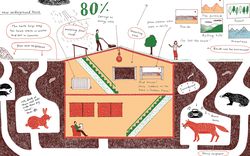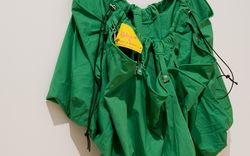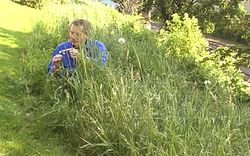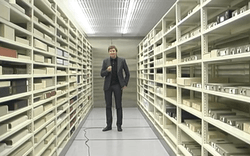From Commodity to Community?
Lev Bratishenko interviews David R. Boyd and Terri-Lynn Williams-Davidson
G. L. Terri-Lynn Williams-Davidson, general counsel of the Haida Nation, and environmental lawyer David R. Boyd discuss the challenges of recognising Indigenous law and the right to a healthy environment in Canada, in a context where corporate, government, and community interests are often contradictory.
- LB
- Can we claim the right to a healthy environment?
- DRB
- There are two ways to answer that question. One is from the perspective of human rights, which are universal, so from a moral perspective, we all have a fundamental right to live in a healthy environment. But moral rights do not actually have much impact until they are turned into legal rights, and at this point in time most Canadians do not have a legal right to live in a healthy environment. I say “most” because the government of Canada does not recognize the right to live in a healthy environment, so unlike the majority of countries of the world, there is no constitutional or national law that recognizes our moral right to live in a healthy environment.
There are laws in two provinces and the three northern territories1 that recognize citizens’ rights to live in a healthy environment. And in the past year and a half an incredible movement2 has begun to push for recognition of the right to a healthy environment across Canada, starting at the local level and building momentum toward changing the Canadian Charter of Rights and Freedoms3 to include that right. So far, more than 140 municipalities have passed declarations recognizing their citizens’ right to live in a healthy environment.
Read more
- LB
- How is the responsibility distributed among the three levels of government—federal, provincial, and municipal?
- DRB
- This is a huge problem in Canada. Our constitution was written in the 1860s and it makes no mention of the environment. When Prime Minister Pierre Trudeau led the repatriation 4 of the constitution in 1982, it failed to include any direct mention of the environment. This problem plagues Canada today because there is uncertainty about who is legally responsible for protecting the environment. It allows all levels of government to evade responsibility and provides a tool that corporations have used repeatedly to challenge the validity of Canadian environmental protection laws. For example, an oil and gas company recently filed a lawsuit challenging the constitutional validity of the federal government’s Species at Risk Act,5 arguing that protecting endangered wildlife belongs under provincial jurisdiction. It is a weaker system than in most countries in the world. More than three-quarters of the world’s national constitutions specify governments’ responsibilities for environmental protection.
Canada has three founding peoples that each brought its own legal system to the table, but in the twenty-first century we still have a legal system that leaves one of them out: it fully recognizes British common law, fully recognizes French civil law, and is only at the very beginning of recognizing Indigenous law. I think that if we did a better job of recognizing Indigenous law then that would greatly benefit our efforts to protect the environment through law. - TLWD
- The Truth and Reconciliation Commission6 has called for Canadians to understand the history of Canada and to realize that we are all benefiting today from the fictions of the doctrine of discovery and terra nullius,7 and we have not done anything collectively or individually about that. This inaction allows governments to continue making decisions without consultation or consent, perpetuating the non-recognition of Indigenous laws.
- LB
- What is the doctrine of discovery?
- TLWD
- It is an international doctrine that when colonizers come to a country and decide that the Indigenous peoples they encounter do not have sufficient social organization—are not “sophisticated” enough to govern themselves—then the land is empty and it can be taken by the colonizers, and therefore “discovered.” Other acceptable ways to acquire land are through conquest or by treaty, and in the absence of both of those—which is the situation here in British Columbia—the doctrine of discovery has allowed the government to enact laws over the land. They “stole it fair and square,” as Louise Mandell says.8
- LB
- What is the “honour of the Crown”?
- TLWD
- I’d like to know that too!
- DRB
- Let me take a shot at it and you can correct me. The term comes from the British monarchy, and we still have the Queen as a figurative head of state, represented by the Governor General. When governments change, the obligations of the Crown do not. For example, King George’s Royal Proclamation of 17639 was a commitment to the Indigenous Peoples of Canada, the people who lived here prior to the arrival of English colonial forces. It guaranteed that there would be treaties prior to any acquisition of land. Instead of stealing the land, there would be negotiated treaties, which would result in the Crown acquiring title to the land of Canada.
The honour of the Crown is related to a legal concept called the fiduciary duty, which means that the Crown has an obligation to look out for the best interest of Indigenous people in its dealings with them. Of course Canadian history has countless examples of the Crown not living up to its legal, moral, or ethical obligations to Indigenous Peoples, so maybe we should talk about the dishonour of the Crown instead. - TLWD
- David and I worked together on the first round of the Haida case.10 When we began this case in 1995, the federal and provincial governments said that First Nations had to prove their rights in court before there would be any substantive rights of consultation or accommodation. The Haida Nation disagreed and eventually brought the case to the Supreme Court of Canada, where the court agreed with us. There was no need to prove rights before there are obligations on the Crown.
But the court made a distinction between the fiduciary duty and the honour of the Crown, saying that the fiduciary duty is engaged when rights are proven while the honour of the Crown is engaged in the interim period before rights are proven in court or defined in a treaty. The Crown has a duty to actually consult and, if required, accommodate First Nations if there are projects that could impact their rights. So it is more than a moral duty but also something less than a fiduciary duty. The exceptions are when an Indigenous nation has proven Aboriginal title or rights in court, is close to negotiated agreement, or has a really strong case that moves Crown obligations into the grey zone of engaging the fiduciary duty. - LB
- If there’s an unresolved claim, the honour of the Crown applies.
- TLWD
- Yes.
- LB
- This gives Indigenous people a tremendous power to intervene in any project that occurs on lands they claim.
- TLWD
- Yes, but unfortunately it requires litigation to show that there are potential rights that engage the honour of the Crown. The developers and the provincial government, who have issued permits or licences for the project, usually resist this. So we end up in a contentious arena until there is a paradigm shift. For example, the Enbridge Northern Gateway11 pipeline and Kinder Morgan12 are both stuck in litigation.
So there is potentially tremendous power there, but it takes a long time and a lot of money to exercise. - DRB
- There is a terrible inequity here. These proposed industrial-resource projects are going to affect Indigenous lands and waters, and because Aboriginal rights are protected by the Canadian Constitution there is a powerful legal tool that can block environmentally damaging industrial developments. But that means asking some of the country’s most impoverished people to stand against projects that are harming the environment that all Canadians depend upon. There is an inequity there that is hard to stomach.
- TLWD
- I agree and have two additional comments. We are impoverished because there was no land allocated to Indigenous Peoples at Confederation. For example, in Haida Gwaii the reserves that were allocated by the federal Crown are 0.01 percent of the land base. Yet when British Columbia joined Confederation13 they were required to provide land to Indigenous Peoples. Reserves are owned by the federal government, not by the Haida, so there is no land base for any sort of economic development.
Second, while Indigenous Peoples are economically impoverished, we are wealthy in culture and in our relationship to the land. We are able to continue nurturing our culture in ways that people living in cities cannot. - DRB
- Ovide Mercredi14 said, and I think it is a powerful thing to say, that we often think of Indigenous people as having treaties with the government, but actually all Canadians are “treaty people,” not just Indigenous Canadians. We forget that, or we never learned it. To fulfil a role as a treaty person changes your perspective about relationships with Indigenous Peoples. It is not only the Crown, it is not just the government that is responsible for Indigenous Peoples and Indigenous lands under our constitution, but it is all Canadians. Except in British Columbia, where there are very few treaties.
- LB
- Is that why there have been so many legal precedents set in British Columbia?
- TLWD
- Yes. When the Crown started negotiating treaties in British Columbia in the 1850s,15 they ran out of funds to negotiate and purchase lands. Then the government started more forcefully promulgating the idea that the land was empty and could simply be taken. The documents from that time are quite blatantly racist in what they say about Indigenous Peoples and the need to remove the land from our care.
- DRB
- As you move west through Canada there are treaties covering most of the provinces. Part of Treaty 8,16 which mostly covers Alberta, spills over into northeastern British Columbia, and fourteen treaties were negotiated on southern Vancouver Island in the 1850s, which leaves over 90 percent of British Columbia as non-treaty territory. I do not think the Crown ran out of money as much as they ran out of will, which in retrospect proved to be a very poor decision. Contemporary treaties are much more costly than historical treaties. There are still some treaties being negotiated; it was a treaty that created Nunavut in 1999.17 But there were no treaty negotiations for about a hundred years until the 1970s.
- TLWD
- There are different kinds of treaties. The earlier treaties are called “Peace and Friendship Treaties” as they did not involve the surrender of any lands. Later treaties involved a surrender of land in exchange for a written articulation of rights and title. Contemporary treaties mostly modify the original Aboriginal rights and title. In Haida Gwaii18 we have not entered into treaty, and we are collaboratively managing the entire land base through interim agreements. That is another approach to take, neither treaty nor non-treaty.
There was so much resource development, so much logging, that the Haida Nation could not wait for a treaty. We had protected Gwaii Hanaas 19 and a quarter of the land base, and the provincial government would only agree to negotiate 10 percent of the territory. We were beyond that, and our overriding concern was protecting the forests. Setting aside the issues of title and jurisdiction meant we could ensure that the forests were protected, so that was the basis for those interim agreements. We are still in negotiations to enter into similar interim agreements for the oceans. - LB
- Did early treaties include much language that we would recognize today as being about the environment?
- TLWD
- No, a lot of the earlier treaties are pretty slim and signed with an X, and likely indicated a substantially different understanding of what they were agreeing to.
- DRB
- They usually had a phrase that said the Indigenous people could carry on hunting and fishing.
- TLWD
- “As formerly.”
- DRB
- Strange language. It’s paternalistic, in that Indigenous people are granted the right to carry on past hunting and fishing when their use of the land was really far more comprehensive than just those two activities. And of course settlers interfered extensively with all Indigenous uses of the land.
- TLWD
- The Supreme Court of Canada kicked off the modern treaty negotiation process with the Calder case, brought by the Nisga’a nation and decided in 1973.20 They lost on a technicality, which was that they couldn’t bring a lawsuit against the Crown.
- DRB
- It was a funny decision. There were seven judges—three found in favour of the Nisga’a, three found against them, holding that their Aboriginal title had been extinguished. The seventh judge ruled against the Nisga’a on a technicality. But it did lead the Liberal government under Prime Minister Pierre Trudeau to begin treaty negotiations just with the Nisga’a.
- TLWD
- Because it was abandoned on a procedural technicality rather than resolved, the decision provided an opportunity to build arguments upon the three judges who said the Nisga’a had Aboriginal title. Even today the Crown never concedes that title exists or that an Indigenous nation holds title. When we argued before the Supreme Court of Canada in 2004, almost every province in Canada intervened against the Haida Nation, arguing that there was no duty to consult or to accommodate Indigenous Peoples, and, more specifically, that the Haida Nation did not have those rights.
- DRB
- Since the 1860s the argument of the Crown has been that the assertion of Crown title across Canada extinguished any existing Aboriginal title that there may have been. Courts have now conclusively rejected that argument.
- TLWD
- One advantage we have in Canada with Aboriginal law that we do not have with environmental law is Section 35 of the Constitution Act,21 which is a commitment to recognize and affirm existing Aboriginal and treaty rights in Canada. Section 35 exists to sanction legal challenges to federal or provincial government actions that could infringe Aboriginal and treaty rights.
- DRB
- In terms of general principles, the Constitution is the highest law of the land and it sets out the rights and responsibilities of governments, it sets out the rights of people, and every law that any government passes has to be consistent with the Constitution or it can be challenged and struck down. But a constitution is more than just the highest law, it also has an important cultural function, and it is striking that in a country as full of natural wealth as Canada, there is no mention of the environment in the Constitution. In 2016, that is a terrible oversight.
I would say that is one of the most pressing problems, and the other, which is perhaps even more deep-rooted, is that we treat nature as property. That has a corrosive effect. It undermines the ability of environmental law to achieve its stated goal, which is protecting and conserving the environment. If we are separate from nature then every square inch of this country is owned by one species. My ten-year-old daughter understands that that does not make sense. If there are tens of thousands of species in Canada, why does one species purport to own it all? That separation between humans and nature, and the treatment of nature as nothing but property, is, I believe, at the heart of environmental law’s failures. Not just in Canada but around the world. - TLWD
- We need more Indigenous perspectives interjected in how we see nature. I often talk about the Haida worldview, in which the land is not owned and all species are actually considered people that should have the same respect as human beings—greater respect, even, because we depend upon them for our existence. From the Haida perspective, cedar trees are considered sisters. Most people would not sell their sister to a multinational logging corporation, yet that is allowed under Canadian law.
- DRB
- Indigenous worldviews and legal systems are being incorporated in other countries in ways that are exciting to me as an environmental lawyer. Ecuador, for example, drafted a new constitution in 2008 with strong Indigenous input, and became the first country in the world to include the rights of what they call Pachamama, or Mother Nature.22 Nature has extensive rights in the new Ecuadorian constitution, and that is groundbreaking.
Bolivia did a similar thing, though not in its constitution, in 2010.23 A more similar example to Canada is New Zealand, where negotiations between the Maori and the government of New Zealand—the Crown in New Zealand—have produced unprecedented agreements and laws that recognize a Maori worldview. They passed a law two years ago that stripped a large area24 of land of its status as a national park with Crown title to the land and acknowledged that the land itself has rights. They took the title that previously was Crown title and vested that title in the land itself. It also defined the land as not just the trees and the rocks and the mountains, but also as including a metaphysical element—that comes from the Maori view of themselves as not just human but in a complex web of relations with the natural world. It is mind-blowing stuff from a legal perspective. - LB
- Traditional Western tools for legal protection of the environment are based on acceptable restrictions to the private control of land. Can you explain land title and Aboriginal title?
- DRB
- Title generally means ownership of the land. Property-rights advocates would say you can do anything with it, but in reality, we have restrictions on what property owners can do with their land. Environmental laws impose some restrictions, and zoning laws in the city impose restrictions.
- TLWD
- In Canadian law, Aboriginal title is a full right of ownership in the land and the resources. It is the right to exclusively use and occupy the lands and resources. It includes a right to benefit economically, but that right is restrained by what the court called an “inherent limit,” which is that the land cannot be used in a way that would prevent future generations from enjoying it in the same way in the future. In effect, it is a sustainability limit. But there is no sustainability limit in Canadian environmental law that applies to licences or tenures granted to resource companies; the concept is completely missing from environmental regulations.
- DRB
- Countries around the world are passing laws and changing their constitutions to include rights for future generations. We have talked extensively about sustainable development in Canada, which is about behaving in ways that safeguard the rights of future generations, but we haven’t done much about it. There is currently a proposal to create a federal advocate for future generations,25 which would be the first step in that direction for Canada. And that would be an exciting development.
- LB
- What does it mean, in terms of our responsibilities to nature, when there are moral responsibilities that are not legal?
- TLWD
- There are substantive rights under the honour of the Crown, and the purpose of the Haida26 case was to confirm that there are legal obligations on the part of the Crown before proof of Aboriginal title. In the Tsilhqot’in case that followed,27 the court clarified that in some cases, once title is proven through treaty or agreement, or through proof in court, some of the tenures that were previously granted could be overturned. That increases the pressure on the government and third parties to work to consult and accommodate.
I began my submissions to the Supreme Court by describing what a Haida house looked like, how the entire space was covered in art and was constructed from old-growth forest.28 Our whole culture depended upon old-growth forests, not just our homes or our transportation, but our hunting, fishing, cooking implements; our ceremonial clothing, our ceremonial masks, our diapers — literally from cradle to grave and into the mortuary poles29 and beyond.
Then I described how it would take the entire community years to raise a longhouse, with ceremonies at different stages; going out for house timbers and bringing them back, and potlatching at each stage; then the raising of the house itself, and paying people for their contributions. I described how the Haida had built a new economic house on Haida Gwaii and how the vision for this house would take the entire community to build. This set the stage for the intervener — the Village of Port Clement — where Weyerhaeuser,30 the licensee we were challenging, was the main employer. The Village told the court that they had more trust in a future with the Haida than they did with the province looking after their rights. That completely undercut the province’s argument that they were representing the public interest and the needs of all British Columbians. - DRB
- I think the word consent is really important because up until now the government has faced a legal obligation to consult with Indigenous peoples in cases where activity may have an adverse impact and to accommodate or compensate them if appropriate, but now Prime Minister Justin Trudeau’s government 31 has said that they are going to implement Canada’s obligations under the United Nations Declaration on the Rights of Indigenous People,32 a document that makes it very clear that you need consent for industrial development activities on Indigenous lands. It would be a great leap forward for Indigenous people in Canada if the government required consent before proceeding with things like pipelines, forestry projects, pulp mills, or liquid natural gas plants.
- LB
- It seems there is an overwhelming practical pressure on anyone who wants to do a project to find a way to work together with Indigenous Peoples and avoid litigation. So is that emerging as the model? Why are projects still going the old route?
- TLWD
- They’re wilfully blind.
- DRB
- It is a clash of worldviews. The best example is the proposed liquified natural gas plant on the coast of British Columbia with facilities on Lelu Island.33 The island is in the traditional territory of Lax Kw’alaams First Nation, and the Malaysian conglomerate behind the gas plant has offered the Lax Kw’alaams a billion dollars. I am sure that the discussion in the boardroom was, “If we offer them a billion dollars, they are going to jump to get behind this,” But the Lax Kw’alaams said, “No, this is not compatible with our view of the future.”
Something is not connecting there. Any company or government that wants to proceed with a major development has to completely rethink its plan in a way that is consistent with Indigenous legal systems and Indigenous cultures. Otherwise it will be stuck in court for the next two decades. - LB
- Because Section 35 of the Constitution gives Indigenous Peoples a special ability to intercede, do non-Indigenous Canadians get to avoid responsibility?
- DRB
- Look at the Enbridge pipeline or the Kinder Morgan pipeline. The City of Vancouver and environmental groups have filed a lawsuit against the Kinder Morgan pipeline, but the reality is the strongest lawsuits against that pipeline are the ones brought by the Squamish First Nation34 and the Tsleil-Waututh First Nation.35 Other Canadians are not shirking our responsibilities, but we do not have the same legal power that Indigenous Peoples have. That is why I think if our Constitution actually recognized something like a right to healthy environment, then other Canadians would have more abilities to fulfil the same role that we are currently asking Indigenous Peoples to fulfil.
- LB
- Do you think that the Constitution has helped to create the stereotype of anti-development Indigenous Peoples?
- TLWD
- That they are radicals.
- DRB
- Yes, radicals. There are lots of stereotypes, but they are all inaccurate. There are hundreds of First Nations in Canada; some of them are leaders in renewable-energy development, but very few of them are leaders in oil and gas development. One of the largest solar projects in Canada was built on Indigenous land by the Six Nations of the Grand River. The T’Sou-ke First Nation on Vancouver Island also has invested heavily in solar power.
- TLWD
- In Haida Gwaii, we do not forbid human activity in any areas. We declared fourteen areas as Haida Protected Areas, meaning we would not allow any industrial development there, and that formed the basis of the land-use agreement that we signed with British Columbia. But we still allow cultural use in those areas. Where it gets more complicated is when we are working through marine-use planning and we see that there are areas that have been so impacted by overfishing that we cannot see any use at all. There may be individual areas, but they are fragmented, so we have to work on building corridors and taking care of the whole, because of course you cannot just protect isolated spaces.
Use is part of preservation and conservation in the Indigenous worldview. But there comes a point where your use is going to prevent your children from using it, and that takes us into a different situation. I think part of the problem with the environmentalist movement has been thinking that there can be areas set aside without any kind of use. - LB
- How do you decide whether something is going to harm future generations?
- TLWD
- It is never easy and it takes a lot of study. We have identified five principles36 that we use for assessing developments, and one of them translates as “seeking wise counsel.” It means integrating scientific knowledge and technical knowledge into the decision along with cultural knowledge. It is one thing to talk about applying Indigenous laws, but now we are applying Indigenous laws to actions contemplated by multinational corporations. There needs to be a broader consideration of values than what is done now; environment and culture are a part of the overall project, and economic interests should not weigh foremost.
- DRB
- As it stands in Canadian law, the purpose of environmental assessment today is to sand off the rough edges of industrial development. It is not about achieving sustainable outcomes for human communities or ecologies. It is an impoverished practice. The government’s environmental protection branch issues permits to companies to do destructive things, so environmental law is authorizing and legitimizing these destructive activities rather than taking a preventive or precautionary approach.
We are in a country where all of the native prairies have been converted to agricultural land. In British Columbia, we are still cutting down old-growth forests, even though there is a dramatically diminished area of them. Environmental law is not stopping those things. - LB
- Does the law ever define an environmental disaster?
- TLWD
- It is usually relegated to environmental effects that are not permanent, basically. It could have hundreds of years of impact, but that is still considered an impermanent effect.
- DRB
- There are only a few valleys of old-growth forest left in British Columbia, but if they are not in parks or protected areas then they are still open for logging. It takes thousands of years for an old-growth forest to evolve, and we do not really know if, given current conditions, they are ever going to come back after we have clear-cut them. Is that an environmental disaster? The law does not look at things that way.
Climate change is an environmental disaster, but we are still burning fossil fuels, we are still cutting down forests, and we are still eating meat on an epic scale. Those are concepts which logic suggests you would talk about when you talk about environmental law. - LB
- What is the precautionary principle?
- DRB
- The precautionary principle is one of those common-sense principles where, if there is some evidence that what you are planning to do is going to cause environmental damage, you should not wait until you have complete certainty that it is damaging before you take action to stop the damage.
Throughout Europe and Latin America the precautionary principle has widespread legal recognition. About a decade ago the European Union passed a new law37 governing the use of chemicals, which reverses the burden of proof. In Canada, the burden is on environmental groups and scientists to prove that a chemical is harmful, whereas in Europe, the burden is now on the corporation that wants to use and sell a chemical to prove that it is safe. Why should chemicals be innocent until proven guilty? It’s madness.
The way the law currently is, we wait until the damage is done, and then we can try to restore the situation. And for all our technological hubris, we do not have the ability to restore what nature has created after three billion years of experimentation. I do not know that we will ever be able to imitate what nature has created or to restore ecosystems that we have destroyed.
Another failure of environmental law in Canada is that it has never taken justice into consideration. The fact is, there is a population in Canada who bear a disproportionate share of the burden of industrial activities and pollution, but we do not have a single law in this country to remedy existing injustices or prevent future ones. It is unbelievable that in 2016 there are no laws that say, if you are proposing a new chemical factory or oil refinery, you must take into consideration the existing burden of those activities on local populations in deciding whether that is an appropriate place to put it. You have communities like the Aamjiwnaang First Nation38 in Ontario, on the outskirts of Sarnia, who are surrounded by more than two dozen oil refineries, petrochemical plants, and polyvinyl chloride plants. It is one of the most horrifically polluted places in North America, and yet new industrial facilities continue to be proposed in this community. There is no law that says we should be even considering such accumulation, let alone preventing it. - LB
- Can you do this in Haida Gwaii? What powers do the Haida have over the islands now?
- TLWD
- The Haida Nation currently co-manages the southern part of Haida Gwaii with the government of Canada through a joint management board, the Archipelago Management Board. Decisions are made by consensus, so the Haida effectively have consent, because half of the board is Haida, and without consensus, a decision cannot proceed. That has been a successful model of implementing consent for the past thirty years. We have implemented the same system with British Columbia over the rest of the land base, although British Columbia has resisted implementing solid dispute-resolution provisions for instances when the co-management council cannot reach consensus.
Ultimately, it will mean going to court or working through some political solution on the ground with the local people if consensus is not reached, so it is not as strong a system as the one in Gwaii Haanas. We do not face any development or any logging in Haida Protected Areas because they are also protected under either provincial or federal law. The Gwaii Haanas model extends into the ocean with the National Marine Conservation Area Reserve. We are currently working to develop an additional interim agreement to combine all of the existing agreements and apply them to both the land and the sea for the entirety of Haida territory. - DRB
- From an ecological perspective, what the Haida have done is really quite remarkable. Over 50 percent of Haida Gwaii is now protected from industrial development. That is the proportion that the world’s leading conservation scientists say we need to protect from development if we are going to turn the tide on the sixth great extinction crisis of planetary history.39 I think that is a remarkable achievement that shows leadership for the rest of Canada, where we are at about 11 percent of land protected from industrial development.
- TLWD
- On the other hand, going back to the inadequacy of environmental assessments, we have protected about three-quarters of the shoreline, but what does that matter if there is an oil spill? We have invested thirty years into building a relationship with Canada and developing a process for making decisions only to have it ignored when assessing a large pipeline that will result in increased tanker traffic transporting crude oil through Haida waters. That was our argument before the Federal Court of Appeal40 in relation to the Enbridge Northern Gateway project: the environmental assessment process must consider other ways of making decisions, such as those embodied in the collaborative management agreements on Haida Gwaii. It comes back to David’s point about environmental assessments. The mandate for this assessment was only to look at mitigation measures, with the assumption that the project would proceed with tinkering here and there to allow it.
Gwaii Haanas is the first place in the world managed from mountaintop to seafloor, and this is because the Haida worldview sees the land and the sea as one. There is no distinction. In Haida oral traditions,41 Raven travels easily back and forth between the ocean realm and the land realm. When he goes into the ocean realm he encounters a land like ours, and the people he meets are people like you and I, except that ocean beings might have a killer whale skin that is worn when visiting this realm. We tried to build a management model that does not put barriers between those two views, considering that whatever decisions we make on the land affects the sea and vice versa. - DRB
- Currently we carve up ecosystems into these ridiculous pieces. Some level of government is responsible for protecting the shore, another for freshwater, another for marine water, another for land, and another for the resources on the land—there is no holistic environmental law currently in Canada. A classic example is management of the Fraser River, perhaps the greatest salmon river on Earth, where dozens of government agencies at federal, provincial, and local levels, multiple First Nations, and many private interests are involved. Some have a mandate to protect the Fraser but lack adequate authority and resources to do so, while those who seek to exploit the river have deep pockets and political power.
- TLWD
- There is no consideration of the cumulative impact of different projects. For instance, in Haida Gwaii, the Haida were referred to logging permits here, road permits there, but the referrals were not showing what the overall impact would be. The province was not taking an ecosystem-based approach to how the logging should be done.
Something that came out of the initial Court of Appeal decision in the Haida case holding that industry had a duty as well as the Crown,42 was that we started doing what we called Haida Land-Use Value (LUV) surveys of the broader ecosystem. Instead of a geographically discrete cutblock-by-cutblock43 approach or one that only took into consideration environmental or economic values, we started assessing values that were important to Haida culture. In these surveys, we look at how many monumental cedars there are, whether there are any medicines nearby with a high profile in Haida culture, bear dens, and endangered or threatened species such as northern goshawks, marbled murrelets or ancient murrelets. The surveys brought in broader values than were, or are, available under the provincial forestry or environmental legislation.
Today the Haida Nation has the largest land tenure, but three-quarters of the forests had already been logged before we won the Haida court case. The best of the best was already gone by the time we came out of the Supreme Court of Canada. - DRB
- If you look at historical photographs of one of the first roads on southern Vancouver Island, the cars are so dwarfed by the old-growth forests they look like toys. There is a train carrying logs, but instead of fifty logs there is only one, and it’s so enormous it takes up the whole car. There are only a handful of places left in British Columbia where you can see that. And if there are only a handful of places in British Columbia, then there are only a handful of places in the world. I call it incremental amnesia: each generation loses more memory of how the natural world used to be.
Nature does have some degree of resilience. The International Whaling Convention44 from fifty years ago has resulted in amazing recoveries of humpback whales and grey whales. When we stopped using DDT 45 in the 1970s there were only four hundred nesting pairs of bald eagles left in the continental United States, and now there are tens of thousands. Go north of Vancouver to the Squamish River when the chum salmon are running in January and you can see more than a thousand bald eagles in a day.
In the early 1970s we discovered that a group of chemicals—chlorofluorocarbons, or CFCs—were eroding the stratospheric ozone layer. It shocked a lot of people that we could actually be destroying a part of the atmosphere that was critical not only to our life, but to all life on Earth. A series of international agreements including the Montreal Protocol46 in 1987 banned CFCs and other ozone-depleting chemicals. By the 1980s, the use of CFCs was down by 99 percent, and the ozone layer was beginning to recover. That is environmental law succeeding in avoiding an existential threat to life on Earth. - LB
- Are there existing alternative legal models that Canada should be looking at in regards to nature—models that don’t include land ownership?
- DRB
- There are only four places that are currently not subject to claims of human land ownership. Part of Antarctica has been set aside pursuant to an international treaty.47 There is a triangle of land between Egypt and Sudan called Bir Tawil,48 which neither country claims. Then there are two places in New Zealand, the former national park that I mentioned earlier and a river that is becoming a legal person as well.49 Those are products of a Maori worldview that has been incorporated into law in New Zealand, another common-law country. I do not know if that would be consistent with Indigenous cultures or laws in Canada, but I would love to see that here as well.
- TLWD
- I do not know if ownership is the problem. I believe that the definition of the rights that go with ownership is the problem. On the northwest coast of Canada, we have a culture that was traditionally very hierarchical with layers of rights that came with responsibilities. A clan could own certain portions of the land, but it was not the kind of ownership that we see today in Canadian society, it was a responsibility to share that land with other people in the community. You could continue to hold that right only if you shared, and only if you fulfilled those responsibilities would you have greater status in the community.
Incorporating that would require a change in worldview and a reconsideration of our history, which has been one of taking and denial—the denial of Indigenous Peoples. I think the biggest problem is having rights separated from responsibilities. In an Indigenous worldview you don’t ever have full rights—you have a bundle of rights with responsibilities. If we incorporated that, I would think we would be a long way toward solving the problems we face today. - DRB
- Those dramatic changes in New Zealand came about through negotiations between Indigenous people and the Crown. I can see that happening here in British Columbia.
The kinds of things Terri-Lynn is talking about in terms of the Haida worldview are difficult for the Western legal mind to wrap itself around, but change can happen surprisingly quickly. When the minister in New Zealand—who is of European descent, not a Maori—introduced the legislation recognizing the rights of the land and also recognizing that it was not just land, but it included both the physical and the metaphysical elements associated with that land, he said, “If you’d have told me fifteen years ago that I’d be standing here talking about Te Urewera, formerly known as a national park, as a person and giving it title to itself, I’d have said you’re off your rocker.” That is quite encouraging.
In the Northwest Territories of Canada there is a strong Indigenous presence, and they brought in a new wildlife act in 201350 that recognizes that wildlife has intrinsic value, and that it is not just there for us to use and own. That was a step in the right direction.
And there is a case going to the Supreme Court because a British Columbia First Nation opposes a massive new ski resort.51 The argument of the Ktunaxa First Nation is that the land has spiritual significance to them, it is where the Grizzly Spirit resides, and that no development of this magnitude should be permitted because it actually violates their right to freedom of religion under the Canadian Charter of Rights and Freedoms. It is a revolutionary argument. I think there is no precedent for it in Canadian law, but it raises the issue in a powerful, clear, and compelling way.
-
Legislation sets out some environmental rights in Ontario, Quebec, the Yukon, the Northwest Territories, and Nunavut. ↩
-
The David Suzuki Foundation launched the Blue Dot Movement in 2014, and over 100,000 Canadians had signed in support as of September 2016. Its goal is to recognize the right to a healthy environment by working from individual support toward municipal declarations, provincial legislation, and finally an amendment to the Charter of Rights and Freedoms. ↩
-
The Canadian Charter of Rights and Freedoms is the part of the Canadian Constitution covering rights and freedoms including freedom of expression, the right to a democratic government, and Indigenous Peoples’ rights. The Charter came into force on 17 April 1982. ↩
-
Through the 1982 Constitution Act, repatriation gave the Canadian government the power to amend its own constitution without involving the British Parliament. ↩
-
The Species at Risk Act (SARA) was adopted in 2002 in part to address the goals of the United Nations Convention on Biological Diversity. In February 2014, an emergency order under SARA to protect the rare sage grouse affected 1,700 square kilometres, including LGX Oil and Gas’s Manyberries oilfield in Alberta. In December, LGX announced that it was suing the federal government for $60 million since the order made the company unable to repay its debt or sell its property (Medicine Hat and LGX Oil and Gas v. Canada (Minister of Environment)). Other companies (Lintus Resources Limited, Swade Resources Ltd, W.F. Brown Exploration Ltd, Barnwell of Canada Limited, and Spyglass Resources Corp.) and the City of Medicine Hat are participating, and the AAMDC (Alberta Association of Municipal Districts and Counties) has begun a provincial process to address associated county tax revenue issues. ↩
-
In 2009, following a formal apology from the Canadian government to Indigenous Peoples, the Truth and Reconciliation Commission began taking testimony to and collecting information from survivors of the Residential School system, a system of forced assimilation that ended in 1986. ↩
-
Meaning “nobody’s land” In Latin, the expression derived from the 1095 papal bull Terra Nullius of Pope Urban II, which allowed Christian European states to claim land inhabited by non-Christians. It came to mean territory that has never been subject to the sovereignty of any recognized state, and could therefore be claimed and occupied. ↩
-
Lawyer Louise Mandell has worked exclusively on Indigenous and treaty rights since 1977, negotiating settlements and asserting rights to hunt and fish in precedent-setting cases like Guerin v. The Queen (1984) and Regina v. Sparrow (1990). ↩
-
With the Royal Proclamation of 1763, King George III set up an administrative structure for the new British territories in North America including rules for relations with First Nations people that form the basis of the treaty process in Canada. Land west of the new colonies was defined as “Indian Territories” and a system for purchasing First Nations land was established. ↩
-
Haida Nation v. British Columbia (Minister of Forests). The second round of this case was the Supreme Court of Canada holding in 2004 that the federal and provincial governments have a duty to consult and accommodate Indigenous groups prior to exploiting lands to which they may have claims. ↩
-
Enbridge’s Inc. multi-billion-dollar Northern Gateway Project would run a twin pipeline system exporting oil and importing gas condensate between Bruderheim, Alberta, and a new tanker terminal in Kitimat, British Columbia. The project would result in tanker traffic from Kitimat to international markets. Studies for the project began in 1998 and the federal government approved it in 2014, but the Federal Court of Appeal found that First Nations were not consulted appropriately and overturned the approval in June 2016. ↩
-
Introduced in 2012, Kinder Morgan’s $5.4-billion Trans Mountain Expansion Project would triple the capacity of an existing oil pipeline from Alberta to British Columbia. Operations along the 1,150-kilometre route began in 1953, the capacity was expanded in 1957, and the route was extended in the 2000s. More than a hundred protesters were arrested in 2014, and the National Energy Board approved the project with 157 conditions in May 2016. ↩
-
Canada was known as the confederated empire of British North America when British Columbia joined on 20 July 1871. ↩
-
Chief Ovide Mercredi is a Cree lawyer, negotiator, author, lecturer, and activist known for his work on constitutional law reform and Indigenous and treaty rights. He is national spokesperson for Treaties 1 through 11. ↩
-
When British Columbia joined Canada in 1871, the Province did not recognize Aboriginal title, so, from its perspective, there was no need for treaties. James Douglas of the Hudson’s Bay Company made fourteen purchases of First Nations land between 1850 and 1854 at the request of the British Crown. These transactions are known as the Douglas Treaties. ↩
-
In the 1870s, mineral discoveries prompted treaty negotiations north of the territories covered by Treaties 1 through 7. Signed in 1899, Treaty 8 was the first of the northern treaties and covered the largest area: 840,000 square kilometres including parts of present-day Alberta, British Columbia, Saskatchewan, and the Northwest Territories. ↩
-
Nunavut, meaning “our land” in Inuktitut, was created on 1 April 1999, altering the boundaries of the Northwest Territories. The idea of dividing the territories was introduced in the 1950s, taken up by the Inuit Tapirisat of Canada (ITC) in the 1970s, and finally implemented with the goal of basing a new government in the culture and language of local peoples. ↩
-
The province of British Columbia and the Haida Nation signed a collaborative reconciliation protocol on 11 December 2001, and the Queen Charlotte Islands were restored to their historical name of Haida Gwaii. ↩
-
As of 1993, a board of representatives with half its members from the Council of the Haida Nation and half from the government of Canada manages the Gwaii Haanas National Park Reserve and Haida Heritage Site. ↩
-
Calder v. British Columbia (AG), the first case in which the Canadian Supreme Court held that Aboriginal title existed before colonization. ↩
-
Section 35 was not included in Prime Minister Pierre Trudeau’s initial proposal for patriation in 1980, which had not involved consultation with Indigenous Peoples. The transfer of constitutional powers from Britain to Canada could have disrupted established agreements affirming Aboriginal rights and title, and First Nations risked losing their status as autonomous decision-makers on a federal level. A two-year campaign of direct action resulted, including the famous Constitution Express, two chartered trains carrying approximately one thousand people to demonstrate in Ottawa. Appeals were also made to the United Nations and the British Parliament before Section 35 was added in 1982. ↩
-
Responding to a history of natural-resource exploration by foreign multinationals, the Ecuador Constituent Assembly worked with the Community Environmental Legal Defense Fund (CELDF) and the Pachamama Alliance to draft constitutional provisions giving nature rights similar to human ones. In 2008, an overwhelming majority of Ecuadorians voted in favor of the change. ↩
-
Ley de Derechos de la Madre Tierra, “Law of the Rights of Mother Earth,” created eleven new rights including the right to life and to exist; the right to continue vital cycles and processes free from human alteration; the right to pure water and clean air; the right to balance; the right not to be polluted; and the right to not have cellular structure modified or genetically altered. ↩
-
New Zealand’s 2014 Te Urewera Act was one of the results of a process addressing issues in the relationship between the Crown and the people of Te Urewera, the Ngai Tūhoe. The Waitangi Tribunal was appointed in early 2002, held eleven hearings on forty claims from 2003 to 2005, and issued the Te Urewera report in four parts from 2009 to 2012. The Tūhoe-Crown Settlement deed was signed in 2013 and came into force through the Tūhoe Claims Settlement Act and Te Urewera Act in 2014. ↩
-
In their June 2016 report, the Standing Committee on Environment and Sustainable Development in the Canadian Parliament recommended that the government “establish an advocate for Canada’s future generations.” ↩
-
In 2004, the Court of Appeal confirmed the legal responsibility of the provincial Crown to consult and substantially accommodate the interests of the Haida. ↩
-
Roger William, on his own behalf and on behalf of all other members of the Xeni Gwet’in First Nations Government and on behalf of all other members of the Tsilhqot’in Nation v. Her Majesty the Queen in Right of the Province of British Columbia and the Regional Manager of the Cariboo Forest Region, et al. Following twenty years of legal proceedings, the Supreme Court granted the Tsilhqot’in a declaration of Aboriginal title over an area of more than 1,700 square kilometres of their traditional territory on 26 June 2014. This was the first confirmation of Aboriginal title outside a reserve, and it was also acknowledged that British Columbia had not consulted appropriately with the Tsilhqot’in Nation. ↩
-
Ancient, never-logged forests. Two of the largest remaining old-growth forests in Canada are the Central Walbran and Edinburgh Mountain forests on southern Vancouver Island. ↩
-
Haida-carved cedar mortuary poles can be made in single- or double-pole designs with a cavity in the top to hold remains. ↩
-
The minister of forests issued what was then Tree Farm Licence 39 to two different logging companies: MacMillan Bloedel Limited in 1981 and 1995, and Weyerhaeuser Company Limited in 2000. All three decisions were made without the Haida’s consent, and the last two against their objections. ↩
-
Justin Trudeau was elected Canada’s twenty-third prime minister on 19 October 2015. ↩
-
The United Nations General Assembly adopted the Declaration on the Rights of Indigenous Peoples on 13 September 2007. In May 2016, Prime Minister Justin Trudeau committed to adopt and implement it fully in Canada. ↩
-
The Lax Kw’alaams currently oppose the Petronas (Petroliam Nasional Bhd.) proposal for an $11-billion liquefied natural gas export plant at Lelu Island, and they rejected a $1.15-billion compensation offer in May 2015. As of August 2016, protesters are occupying the island. ↩
-
The Skwxwú7mesh stelmexw (Squamish People) are a Coastal First Nation concentrated in the area now described as the lower mainland of British Columbia. ↩
-
“The People of the Inlet” are one of many Coast Salish First Nations living in the Pacific Northwest throughout British Columbia, Washington, and Oregon. Their traditional territory is in the area now known as Burrard Inlet in North Vancouver. ↩
-
Translated as “Respect, Responsibility, Balance, Giving and Receiving, and Seeking Wise Counsel.” ↩
-
Regulation (EC) No. 1907 concerning the Registration, Evaluation, Authorisation and Restriction of Chemicals, the REACH regulation was passed in 2006. ↩
-
The Aamjiwnaang (“at the spawning stream”) First Nation is an Ojibwa-speaking community of about 2,300 in southwestern Ontario on the St. Clair River, south of Lake Huron. ↩
-
The earth is currently experiencing the greatest loss of biodiversity since the extinction of the dinosaurs sixty-five million years ago. The American evolutionary biologist E. O. Wilson has calculated that the only way to stop such an extinction would be to protect half of the earth from development for the ten million species that are not human. ↩
-
Gitxaala Nation et al. v. Canada, 2016 FCA 187, decided in favour of the Gitxalla on 30 June 2016. ↩
-
A cycle of stories where Raven, the trickster, shows lessons and laws for human conduct through such actions as bringing light to the world. ↩
-
Haida Nation v. BC and Weyerhaeuser (2002). This duty was not upheld by the Supreme Court of Canada, which affirmed that the Crown cannot delegate any duties of consultation or accommodation to third parties. ↩
-
An area designated for logging. ↩
-
Signed in 1946, the International Convention for the Regulation of Whaling includes a schedule with catch limits for commercial and Indigenous subsistence purposes. ↩
-
DDT (dichlorodiphenyltrichloroethane) was never manufactured in Canada but was widely used as an insecticide in the 1950s and 1960s. Most uses were banned in the 1970s, the registration of any uses was discontinued in 1985, and all stocks were to be destroyed by the end of 1990. It is a toxic substance managed under Schedule 1 of the Canadian Environmental Protection Act. Internationally, it remains legal to combat outbreaks of malaria. ↩
-
Following the discovery of the Arctic ozone “hole” in the 1980s, an international campaign successfully banned some of the chemicals responsible: chlorofluorocarbons, halons, carbon tetrachloride, methyl chloroform and chlorobromomethane. The Montreal Protocol on Substances that Deplete the Ozone Layer was agreed on in Montreal on 16 September 1987, came into force as of 1 January 1989, and was adjusted and amended into the 2000s. The global ozone layer is projected to return to pre-1980 levels by around 2050, and the Antarctic ozone layer around fifteen years later. ↩
-
Twelve countries signed the Antarctic Treaty on 1 December 1959. There are now fifty-three parties to the treaty, which includes provisions for peaceful use of Antarctica and the sharing of scientific findings. ↩
-
Bir Tawil is a two-thousand-square-kilometre area between Egypt and Sudan. Each country attributes it to the other in order to maintain consistency with conflicting colonial documents from 1899 and 1902 that support their claims to another region, Hala’ib, where oil has been found. ↩
-
As of September 2016, the Te Awa Tupua Bill, which would put into effect the Whanganui River Deed of Settlement signed on 5 August 2014, is in process in the parliament of New Zealand. The Select Committee’s report is due in November 2016. ↩
-
The Northwest Territories’ new Wildlife Act entered into force on 28 November 2014. Section 2 states: “Wildlife is to be conserved for its intrinsic value and for the benefit of present and future generations.” ↩
-
Ktunaxa Nation Council and Kathryn Teneese, on their own behalf and on behalf of all citizens of the Ktunaxa Nation v. Minister of Forests, Lands and Natural Resource Operations. The Supreme Court of Canada granted the Ktunaxa leave to appeal on 17 March 2016; written arguments will be accepted from fourteen interveners including other First Nations into October and from respondents into November. ↩
This text was originally published in It’s All Happening So Fast, A Counter-History of the Modern Canadian Environment, edited by Lev Bratishenko and Mirko Zardini on the occasion of our exhibition of the same name. G. L. Terri-Lynn Williams-Davidson is general counsel of the Haida Nation and has represented the Haida in litigation and negotiations at all levels of court including the Supreme Court of Canada. David R. Boyd is an environmental lawyer and adjunct professor in resource and environmental management at Simon Fraser University.












